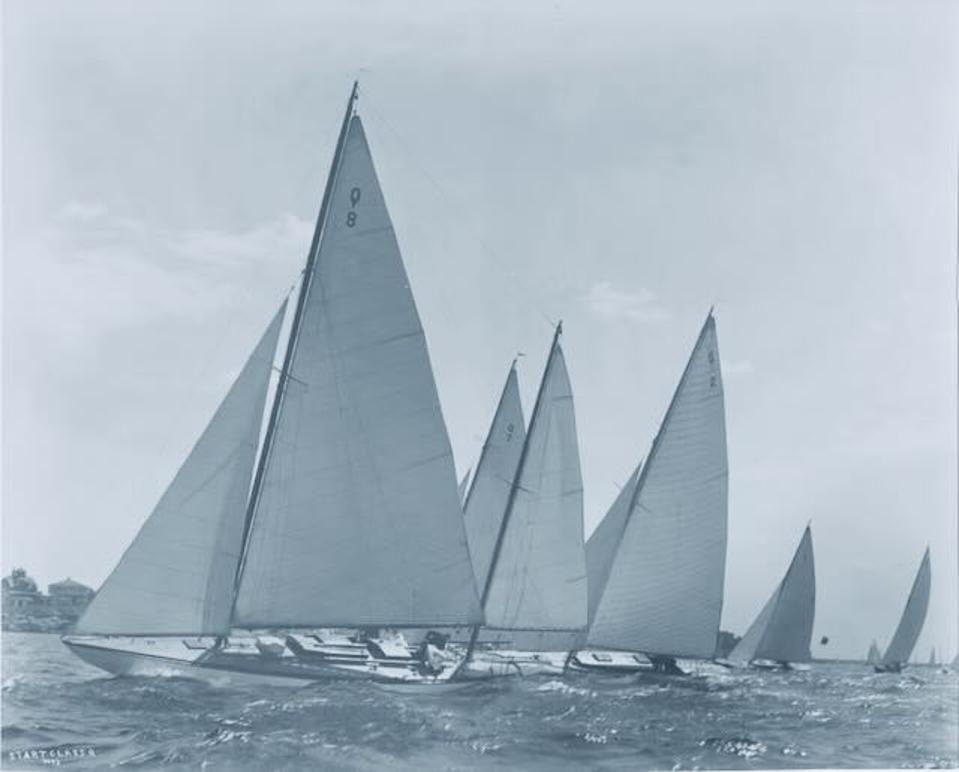Everyone loves J Boats, the epic yachts of the 1930s era of America’s Cup racing. These streamlined yachts, with extreme overhangs, narrow beams, and deep keels, hark back to a romantic era in the 1920s and 1930s when the Captains of Industry manned the helms, racing under glorious sail with spinnakers flying.
J Class yachts are extraordinary. They are big. And expensive. They require a large crew of about 30 hands to sail effectively. That’s a lot to organize for an impromptu afternoon sail, or a weekend regatta. There is an interesting and historic option on the horizon, and Peter Silvester, founder and CEO of Q7 Yacht Designs, is intent on sharing it with passionate sailors.
The Birth Of The Q Class Yachts
Before the J Class was a thing, there was the Q Class. Q Class yachts were designed in response to early 1900s yacht classifications rules abuses under the Seawanhaka Rule. Extreme yacht designs aimed at gaining a racing advantage began to cause serious accidents and incidents, some fatal.
A new rule devised by Nathanael Herreshoff added displacement into the classification equation giving rise to the new Universal Rule used to assign classifications, similar to a golf handicap, to sailing yachts. The formula effectively divided the speed-giving element, or the boat length times the square root of the sail area, by the speed-impeding elements, or the cube root of the dead weight, making displacement a relevant part of the equation.
The New York Yacht Club adopted the Herreshoff Rule, renaming it Universal Rule, in 1903. New designs for the Q Class quickly followed.
Like the J Class, very few Q Class yachts survived the devastation caused by World War II, leaving hulls in various states of neglect. Recognizing the exceptional form and function of the yachts and their ease of use, interested sailors began to invest in rebuilds of select hulls. One company, in particular, created Q7 Yacht Designs to maintain, sail, and race the original Q Class vessel Falcon.
Q7 Yacht Designs and The Falcon Study
Silvester is dedicated to the resurgence of the Q Class, and has commissioned a new build and a new Q Class Falcon Study to show the world what this yacht can do. After Silvester found Falcon, which had been beautifully restored by John Anderson but on the hard for years, he became Falcon’s caretaker and found her an exciting sailing yacht deserving of a second chance. Thus, he initiated the Falcon Study and the new build process for a revival of the Q Class.
“Our mission is to celebrate the legacy and heritage of ‘Falcon’, a classic 1926 Q Class racing sailboat, designed to the Universal Rule of Measurement and manufactured by the Herreshoff Manufacturing Company,” Silvester states.
The original 1926 Q Class Sloop Falcon was designed by Burgess, Swasey & Paine. After meticulous restoration, Falcon is again functional and fabulous. The Q7 Yacht Designs team regularly sails and races Falcon in San Diego, California.
The New Q Class Design
Silvester has worked closely with partners to bring the Q Class designs up to date, reimagining the original Falcon, optimizing the design to Universal Rule standards, and commissioning a new Q Class build under the Falcon Study banner with Dykstra Naval Architects on design and Spirit Yachts of the UK for the build.
“Imagine the beauty and performance of a 1920’s racing sloop but manufactured today, combining traditional craftsmanship with the latest systems and materials – that’s the Q7 ‘Falcon Study’, ” Silvester suggests.
Translating the original hull lines into an elegant new commission, Q7 Yacht Designs sought excellence in systems, and materials. In concert with Dykstra’s expertise in design and Spirit Yachts’ impeccable reputation for craftsmanship, all signs indicate that the Q7 Falcon Study will produce a modern classic Q Class yacht that remains authentic to form, while cleverly outfitted with modern conventions that will turn heads and collect a faithful following.
To make sure the new build is distinctively a Q Class yacht, every effort was made to follow Falcon’s sleek silhouette with original hull lines, full keel, and fractional rig. Built by hand using top of industry wood and epoxy construction and state-of-the-art techniques, the newest Q Class yacht will remain true to the Universal Rule Q Class rating.
Q7 Falcon Study Details
This new Q Class Falcon will have electric winches and the utmost in electronics and instrumentation. Fully recyclable sails, electric propulsion with regenerative capability, bow thruster, head sail furling system, carbon mast, boom, and rigging with a performance package from One Sails all contribute to improved performance. There will be generous accommodation for two with electric head, shower, and hot water, and accommodation for four crew berths for regatta weekends.
In 2026, the Falcon Q Class yacht will mark 100 years since she first appeared on the regatta scene. In a celebratory tribute, the Falcon Study will launch the new Q7 build to commemorate that anniversary.
“We’ve worked hard with the teams at Dykstra and Spirit Yachts to ensure we retain the spirit, essence and heritage of Falcon in the new Q7,” Silvester notes, adding, “I’m not a professional sailor but the fact that America’s Cup/Sailing legends like Dennis Connor and Bruno Troublé chose Q Class yachts to own and race should tell you everything you need to know about what a joy they are to sail.”
As the reimagined Falcon approaches completion, events will celebrate the new build, inspiring passionate sailors to follow suit. “We’re looking forward to providing updates on our adventures in the original ‘Falcon’ and updates on the Q7 ‘Falcon Study’. Stay tuned!” Silvester concludes.

